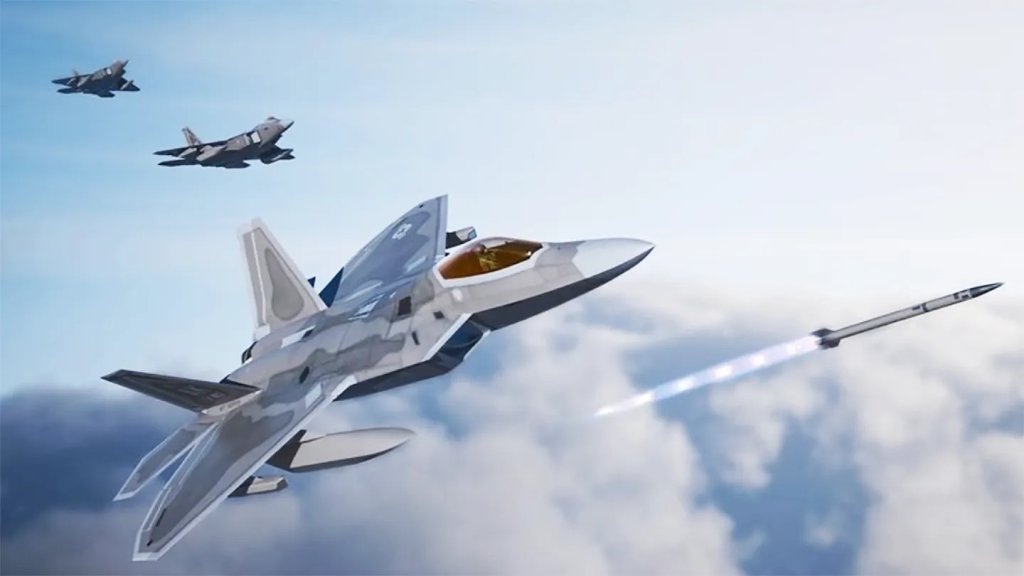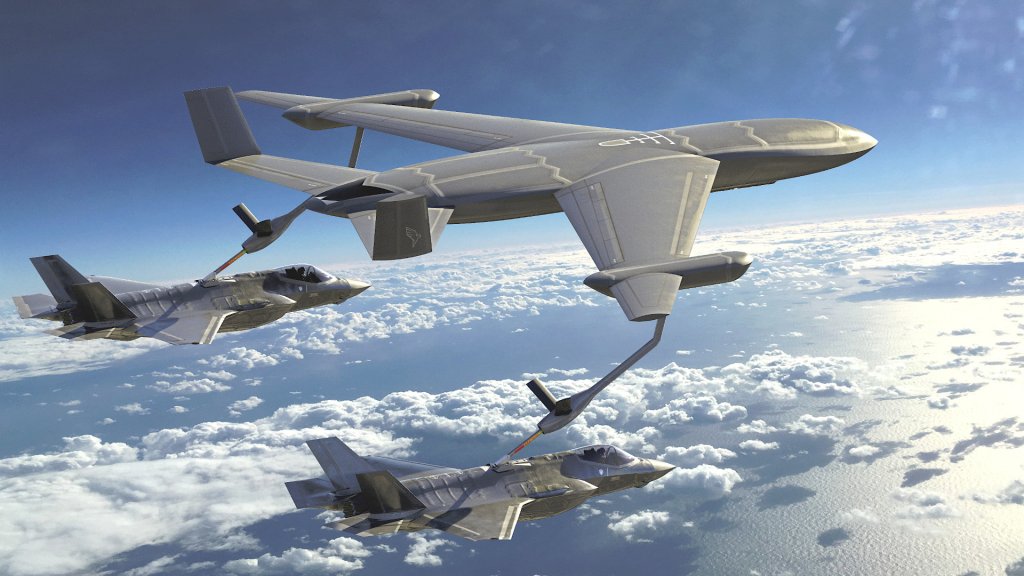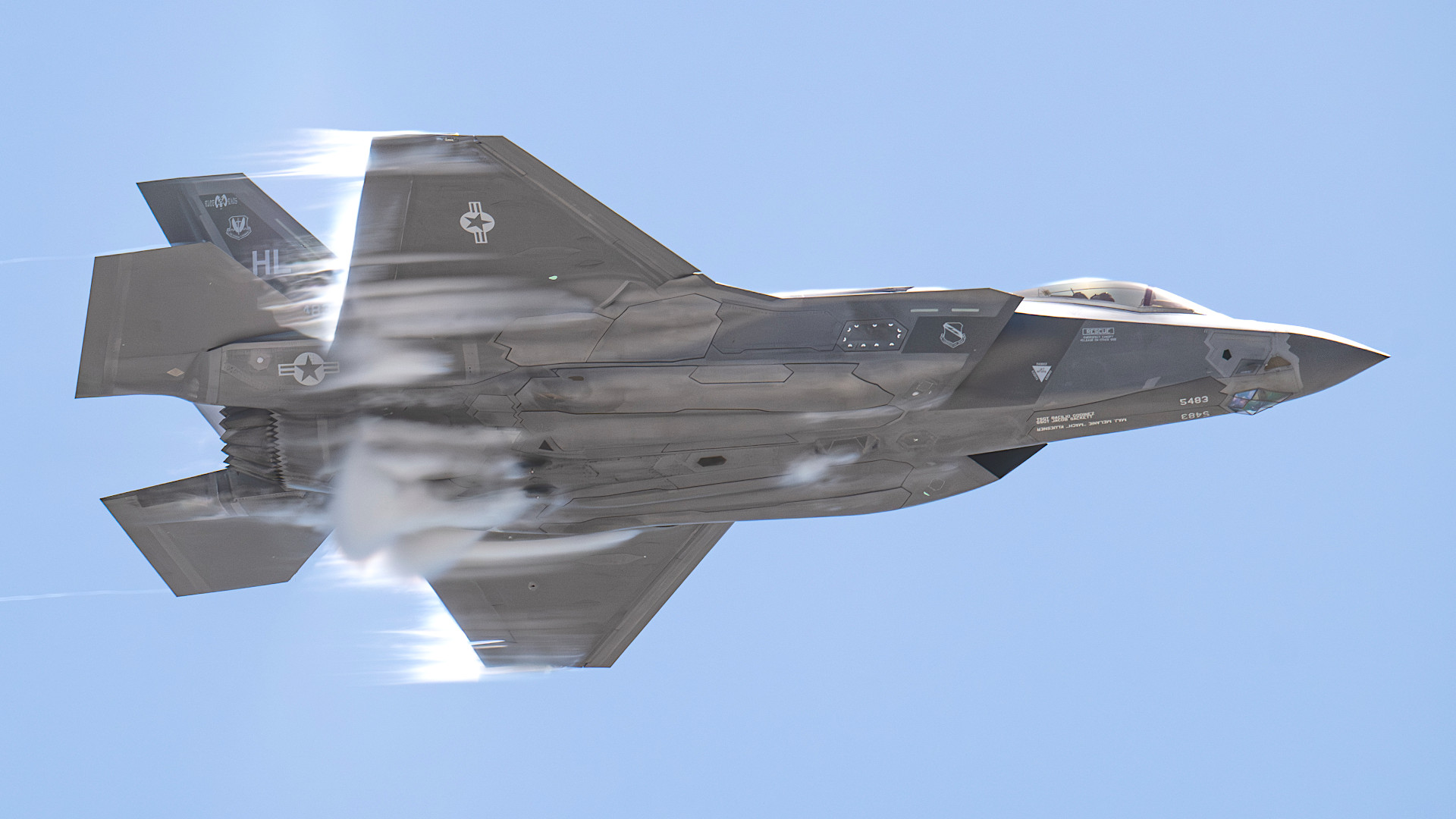Range-extending external fuel tanks for the F-35 Joint Strike Fighter have re-emerged as part of the ongoing Block 4 modernization effort for those aircraft, years after a requirement for streamlined drop tanks was eliminated. More recently, the Israelis reportedly did additional work on drop tanks, as well as conformal fuel tanks (CFT), for the F-35I variant. External tanks could be especially important for carrier-based F-35Cs in service with the U.S. Navy, now that the service’s plans for a longer-ranged F/A-XX sixth-generation fighter are set to be put on hold.
The U.S. Air Force is requesting funds to explore adding external fuel tanks to the F-35 in its proposed budget for the 2026 Fiscal Year. The current combat radius of the land-based F-35A is generally stated to be around 670 nautical miles (close to 1,241 kilometers). The reach of the carrier-based F-35C variant is slightly longer, while that of the short-takeoff and vertical-landing capable F-35B version is significantly shorter. All F-35s can also be refueled in flight.

The immediate goal is to “evaluate feasibility and decompose requirements for integration of External Fuel Tanks to support long-range missions of the F-35,” per the Air Force’s proposed Fiscal Year 2026 budget.
Whether or not “External Fuel Tanks” here means drop tanks or CFTs, or if both could be considered, is unclear. It is also not clear if this work will be focused, even just initially, on the F-35A variant that the Air Force flies. TWZ reached out to the F-35 Joint Program Office (JPO) for more information, which directed us to contact the Air Force. Lockheed Martin had also directed us to contact the JPO for any additional details.
The Air Force budget documents also do not say how much money the service is looking to put toward this work. It is rolled in with a larger request for nearly $432 million to support ongoing Block 4 modernization work. The Block 4 upgrade effort consists of a wide range of hardware and software improvements that are set to be added to all three F-35 variants on a rolling basis as part of a broader effort referred to as Continuous Capability Development & Delivery (C2D2).

“As designed, Block 4 consists of three principle lines of effort: development of software-based capabilities, development and integration of new and modernized aircraft hardware which enable the development of new capabilities, and new weapons integration,” according to the Air Force’s latest budget request. “Block 4 upgraded capabilities and continuous improvements will maintain Air System viability against the evolving threats indicated in the Electronic Warfare Initial Capabilities Document (ICD), the Fifth Generation Fighter Modernization ICD, and the Block 4 Capability Development Document (CDD). Additionally, the Block 4 capabilities will reduce life cycle cost, improve Air System Integration, and improve operational suitability.”
At present, Block 4 includes a new radar and other improved sensors, significantly upgraded electronic warfare capabilities, modernized communications and navigation capabilities, and an expanded arsenal.
“Weapons integration efforts under this project deliver increased lethality, effectiveness, situational awareness and operational flexibility, and include M-code GPS compatibility, Advanced Integrated Fire Control implementation, network enabled weapons, increased Air-to-Air missile carriage, and employment envelope expansion,” the Air Force’s Fiscal Year 2026 budget proposal adds. “Beyond Line of Sight (BLOS) efforts under this project will deliver increased range and effectiveness of the F-35, by providing improved interoperability across joint platforms within a highly contested environment.”
As noted, the idea of external fuel tanks to extend the range of F-35 variants is not new. Between 2004 and 2007, Lockheed Martin conducted design studies on 480- and 460-gallon underwing drop tanks. The company did additional work related to drop tanks as part of a larger range-extension study in the 2018-2019 timeframe amid a resurgence of interest in that capability.


In 2019, Aviation Week reported that Israel Aerospace Industries (IAI) and Cyclone, a subsidiary of Israeli firm Elbit Systems, had finished initial design studies on 600-gallon drop tank and CFT designs for the F-35I. The F-35I is a unique subvariant of the F-35A, as you can read more about here. The following year, the Jerusalem Post reported that the Israeli Air Force (IAF) had fielded an unspecified range-extending capability for the Adir, which could also have included modifications to the engine and software tweaks, with a particular eye toward enabling unrefueled strikes on Iran. The extended-range capability was reportedly employed during the recent Israel-Iran conflict, but details, including whether it utilizes external and/or internal auxiliary fuel tanks, remain scant.

“There is no approved program of record requirement for auxiliary internal fuel tanks,” the F-35 JPO had told TWZ in response to queries about extending the range of the Joint Strike Fighter in January. At that time, Lockheed Martin also directed us to contact the JPO.
It is worth noting here that developing external fuel tanks, which impart drag and add weight, for any fast-flying combat jet presents certain challenges. The range-extension benefits have to outweigh these other factors. Lockheed Martin notably abandoned its original 480-gallon drop tank for the F-35 after aerodynamic and stores separation issues emerged. The subsequent 460-gallon design, which was also not ultimately pursued, had a significantly different shape.
There are additional complications when it comes to devising external fuel tanks for stealthy aircraft, which can negatively impact their radar-evading characteristics, if not negate them entirely. Precisely engineered, flush-mounted CFTs, may be less problematic in this regard than drop tanks. Drop tanks and their pylons can also be jettisoned to help restore some of a jet’s low-observable (stealth) profile, but it is an imperfect option. Stealthy drop tanks are notably already in development for the U.S. Air Force’s F-22 Raptors to help mitigate limitations imposed by the traditional types those jets are currently certified to carry.

Some F-35 missions will not require the jets to fly in their most stealthiest configuration, either. Joint Strike Fighters are already capable of carrying munitions and other stores externally, as required.
All told, an increase in unrefueled range through the integration of new external fuel tanks could be beneficial for U.S. F-35s, as well as those in service with other countries. Aircraft range, broadly speaking, has already emerged as a central consideration for the U.S. military when it comes to planning for any potential conflict across the broad expanses of the Indo-Pacific. The steadily evolving and expanding anti-air threat ecosystem, especially in the context of a possibly high-end fight with China, has already been driving general interest in greater unrefueled reach for tactical jets. The Air Force says its forthcoming F-47 sixth-generation fighter will have a combat radius in excess of 1,000 nautical miles.

F-35s can refuel in mid-air, but there are additional questions about the growing vulnerabilities of existing non-stealthy aerial refueling tankers, which would be top targets in any future major conflict. The U.S. Air Force is still in the very early phases of work on a Next Generation Air-Refueling System (NGAS) ‘system of systems,’ which could feature new stealthy and/or uncrewed tankers by 2040. The service is also exploring other capabilities in this regard, including new boom-equipped podded aerial refueling systems that other tactical jets could carry.

In addition to greater overall reach, extra onboard fuel for F-35s could translate to more loiter time over a target area. This could also help reduce the need for tanker support, which would be in high demand, in general, including for Joint Strike Fighters flying from forward operating locations close to the fight.

It is also worth pointing out here that the F-35A and F-35C already offer a very good combat radius with a useful payload compared to many other non-stealthy combat jets in U.S. and foreign service today, while also flying in their most low-observable (stealthy) configuration. This, in turn, points to additional drivers behind the emergence of new interest in external fuel tanks.
As mentioned, there could be a particular new demand signal when it comes to external fuel tanks for the F-35 from the U.S. Navy. In recent years, the service had been pushing ahead with plans for a new carrier-based F/A-XX sixth-generation stealth fighter that would offer around 25 percent greater reach than the F-35C, or roughly 837.5 nautical miles (just over 1,551 kilometers). TWZ previously noted that was already less additional range than had been expected. Now, in the proposed Fiscal Year 2026 defense budget, the Pentagon is moving to shelve the F/A-XX program indefinitely, primarily to ensure resources can be focused on the Air Force’s F-47.
The Navy has separately seen delays and cost growth dog its plans to field new MQ-25 Stingray tanker drones, which the service also expects to help extend the reach of its carrier air wings. As it stands now, the MQ-25 is not set to reach initial operational capability until the middle of 2027, three years later than originally expected. Once the Stingrays do begin entering service, there is the distinct possibility they could evolve into much more than tankers, as TWZ outlined in this past feature.

Further underscoring this, the Navy had also put out a call for “innovative concepts” to extend the range of its F/A-18E/F Super Hornet fighters and EA-18G Growler electronic warfare jets. The service said it would be willing to consider ideas including, but not limited to “methods to increase lift, reduce drag, increase fuel available, reduce fuel usage on the deck, increase engine performance; and/or adjustments to subsystem integration and/or architecture or advanced flight controls.”
Beyond the U.S. military, foreign F-35 operators without significant (or any) organic tanker support are also likely to be very interested in external fuel tanks to extend the range of their jets. Israeli efforts to increase the reach of their F-35Is were driven in part by the small size of that country’s tanker fleet.
When any new external fuel tanks may begin to enter service on U.S. F-35s, or other Joint Strike Fighters outside of Israel, remains to be seen. The Block 4 upgrade program, as a whole, has suffered its own delays and cost growth. The Fiscal Year 2026 U.S. defense budget proposes to slash purchases of new F-35s in part to provide more funding for the Block 4 effort, as well as to help sustain existing Joint Strike Fighter fleets.
The problems with Block 4 have been further compounded by issues with the development of underlying hardware and software updates, called Technology Refresh 3 (TR-3), which F-35s need to receive first before they can get any parts of the Block 4 package. Since May, Lockheed Martin executives have been publicly saying that they are of the view that work on TR-3 is now complete. However, the Fiscal Year 2026 budget request indicates more work to be done, at least on the U.S. military side, which could continue into next year.
In Fiscal Year 2026, “the TR-3 program will continue the completion of the final laboratory system integration and test, and system certification requirements for fleet fielding,” according to the Air Force’s budget documents.
If nothing else, the U.S. military does at least want to take another hard look at external fuel tanks for the F-35 amid growing demand for greater reach without the immediate need for tanker support.
Update: 7/1/2025 –
A Department of Defense (DOD) official has now provided the following statement regarding external fuel tanks for the F-35:
“The DoD will explore [the] feasibility of all forms of external fuel tanks, to include under-wing tanks, for all three variants of the F-35.”
Howard Altman contributed to this story.
Contact the author: joe@twz.com
